The pump is the heart of your pool, circulating water to keep it balanced. But not all pumps are created equal—each pool has its own filtration, runtime, and power needs.
Whether you’re installing your first pool pump or upgrading to something better, make sure you know what to look for when choosing the right one for your pool (jumps to the bottom of the page).
Available in 1.5 HP, 2 HP, & 3 HP sizes.
The Future is Variable-Speed Pumps
Variable-speed pumps are the new kids on the block. They allow you to control your RPMs to whatever setting you need. Most variable-speed pumps have schedules that allow you to move water as fast or as slow as necessary.
Whether you want to buy a pool pump for a new setup or a replacement, we only recommend variable-speed pumps. With new DOE regulations on single-speed pumps, and even some states starting to prohibit the shipping of single-speed pumps, variable-speed pumps are a no-brainer.
Beyond the regulations, they offer much better control and automation. While they are more expensive up front, they consume less power and are energy efficient, saving you money in the long run.
The Best Variable Speed Pumps Available
Pentair SuperFlo VS

*As an Amazon Associate, I earn from qualifying purchases at no additional cost to you.
- Warranty: 1 year
- Horsepower: 1.5 HP
- Voltage: 115 / 230 volts
- Freeze Protection: No
- WEF: 9.0
- Energy STARCertified: Yes
Pros
Cons
The most well-rounded pump for the average swimming pool is the Pentair SuperFlo. Pentair has built its brand as one of the most well-known and trusted pump manufacturers, and the SuperFlo packs a lot of punch at a pretty affordable price point. With a self-proclaimed 80% reduction in energy costs, it may even pay for itself after a few seasons!
One reason this pump is great is that it is compatible with 115 and 230 volts. If this is to replace an older single-speed pump, you don’t need to rewire your panel, which can be an expensive switch.
The SuperFlo is a very easy pump to install. It has the same dimensions and is a drop-in replacement for the Hayward Super Pump.
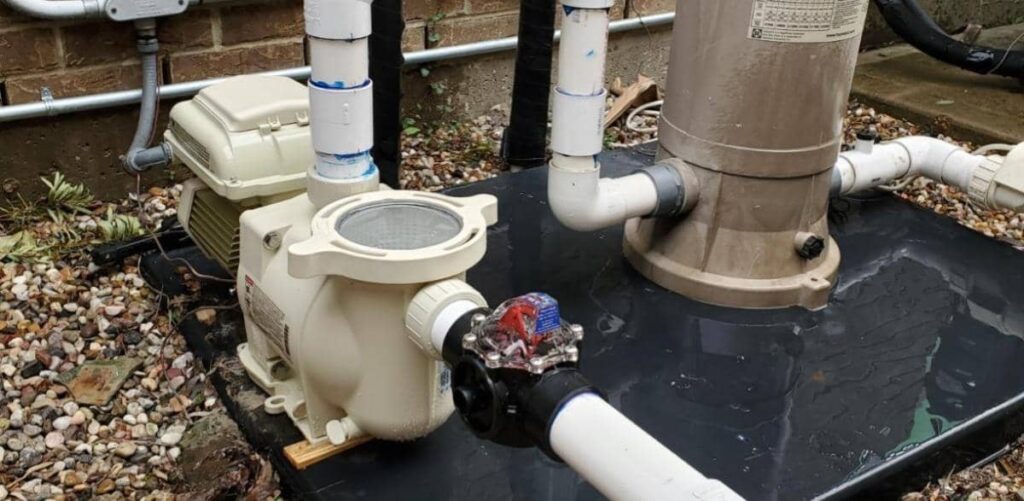
It also comes with unionized fittings for both 1.5″ and 2″ piping, another action that doesn’t require reformatting your pool pad! The fittings also make it simple to remove and store over the winter months if you don’t want to keep it outside (note: this is optional as these pumps are rated to withstand winter climates).
Keep in mind that while there is a 1-year warranty, self-installation will void that warranty. This isn’t uncommon, as most manufacturers require a professional installer to honor warranties. Research suggests a 60-day warranty for pool owners who install themselves, which is still better than a complete void.
In terms of operation, the SuperFlo is very quiet. Its totally enclosed fan-cooled (TEFC) motor is designed to make minimal noise when in operation. When operating at lower speeds, unless you are right beside it, you wouldn’t even be able to tell if it was on.
The 24-hour clock display and the keypad are very simple to program. The one downside to the scheduling itself is that it only has three separate speed programming options, which is less than other pump models. This shouldn’t be too big of a problem for most pool owners, but it is something to note.
There is also no built-in freeze protection. If you have bouts of freezing conditions while the pool is in operation, you are responsible for making sure it is running the entire time.
For the more high-tech pool crowd, there is also to ability to automate with RS-485 wiring.
If you have a connected spillover spa or tons of water features like bubblers and waterfalls, this pump may not be for you. However, 1.5 horsepower is more than enough for most pool owners to keep water moving and filtered all day. And the SuperFlo is as reliable as they come.
Hayward MaxFlo VS

*As an Amazon Associate, I earn from qualifying purchases at no additional cost to you.
- Warranty: 3 years
- Horsepower: 1.65 HP
- Voltage: 230 volts (115 volt version also available)
- Freeze Protection: Yes
- WEF: 10.16
- Energy STAR Certified: Yes
Pros
Cons
Boasting as the “most efficient pool pump of its kind” with up to 80% energy savings, the Hayward MaxFlo VS is another popular pool pump that meets the necessities of most swimming pools. Hayward is known for making high-quality pool equipment, and the MaxFlo fits the bill.
Like Pentair, the MaxFlo was designed to be a drop-in replacement for the most popular pumps, making installation much easier. If needed, Hayward offers a riser base to align with other pump models, like the Sta-Rite Dyna-Pro.
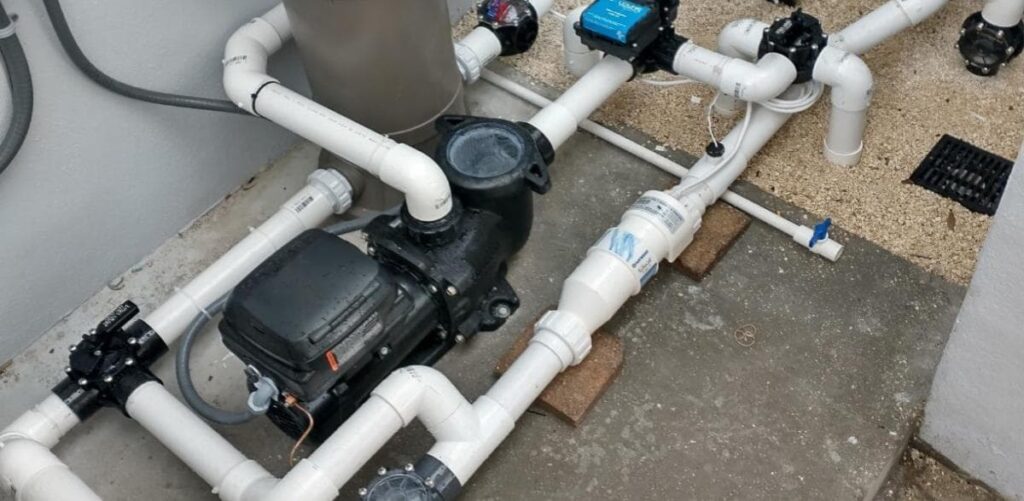
Hayward offers a pretty generous 3-year warranty for their pumps, but “improper installation” may limit the length of the warranty. As mentioned, this is a fairly common practice, so read the full warranty description for the most accurate information.
With a totally enclosed fan-cooled (TEFC) motor, this pump has been one of the quietest I have operated and tested. Even at higher RPMs, you’ll barely hear it in the pool.
Operation and programming are also quite simple. You can program up to four different speeds over a day, which should be more than enough to filter and turn the water over. The actual touchpad can rotate to four different positions or be mounted to a wall.
One thing to keep in mind is that the pump itself has separate models available for 115v and 230v connections. So double-check your electrical output, as wiring a pump on the wrong voltage can cause permanent damage and may void the warranty.
Overall, the Hayward MaxFlo VS is a well-rounded variable-speed pump that balances energy efficiency, performance, and quiet operation. With 1.65 horsepower, it is more than capable of handling any smaller or medium-sized pool.
Black and Decker VSP

*As an Amazon Associate, I earn from qualifying purchases at no additional cost to you.
- Warranty: 5-year
- Horsepower: 1.5 HP, 2 HP, and 3 HP models (1 HP model for above-ground)
- Voltage: 230 volts
- Freeze Protection: Yes
- WEF: 8.3
- Energy STAR Certified: Yes
Pros
Cons
READ: Full Black and Decker VSP Review
Note: I am currently using this pump going on four swim seasons.
This may be the first time you hear of a pool pump made by Black and Decker. If that is true, do note that it is not a joke. In fact, a very well-made pump at an affordable price!
The first item that may jump out at you is the mind-boggling 5-year warranty. Research online shows a very favorable and reliable customer service that honors the warranty when necessary. There is also no mention of “professional installation” in documents, so keep that in mind.
A DIY installation of the pump is quite simple. It also comes packaged with a removable base to meet the height requirements of many popular pump models from Pentair, Hayward, and Sta-Rite.
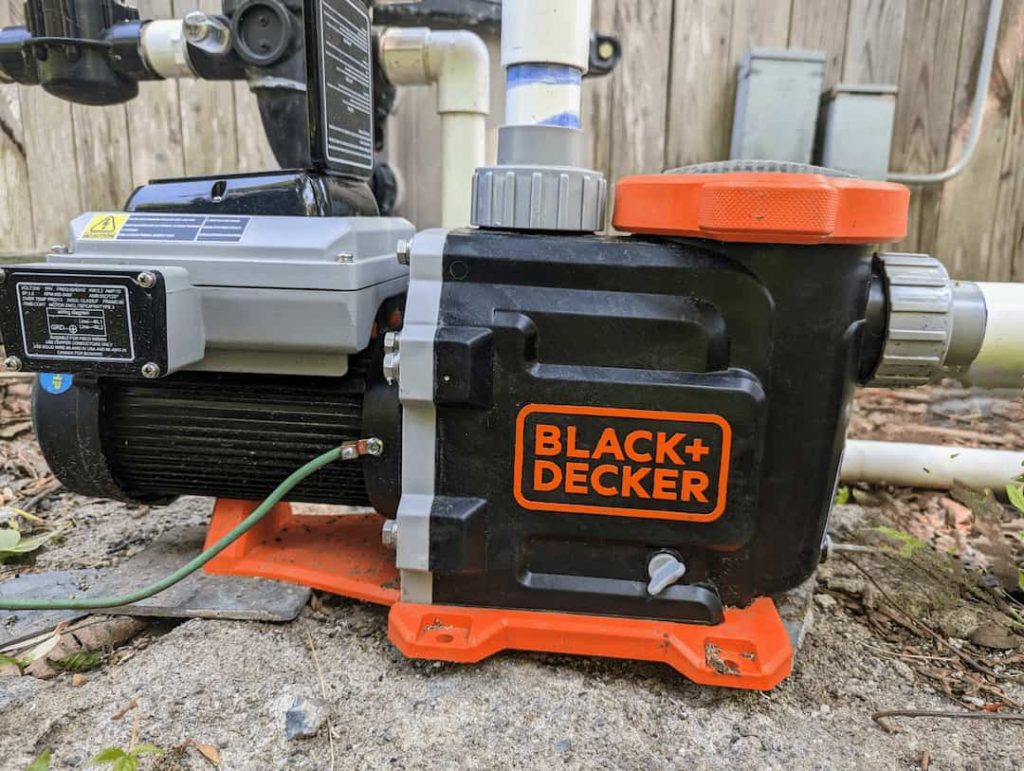
The pump is also packaged with CPVC adapter unions for both 1.5″ and 2″ pipes to satisfy most residential pools.
With a TEFC motor, the Black and Decker pump is also very quiet when operating. Watch below to hear what the pump sounds like at different RPMs:
The design of the control panel is simple enough with four programmable buttons to schedule RPM levels throughout the day manually.
All Black and Decker models for inground pools are wired for 230v only. Consider this if your electric capacity is only 115v.
Also, since it is a Black and Decker, the color scheme doesn’t let you forget it! The bright orange may be offputting for some people who like aesthetics, but a quick paint job could fix that problem.
While Black and Decker doesn’t have the name recognition of Hayward or Pentair, it is manufactured by Blue Torrent Pool Products, a well-known company in the pool industry.
With 1.5, 2, and 3 horsepower models, this pump is available for any size pool. So, if you are looking for a variable-speed pump at a more attractive price point, The Black and Decker VSP is a great option.
Hayward TriStar VS

*As an Amazon Associate, I earn from qualifying purchases at no additional cost to you.
- Warranty: 3 years
- Horsepower: 1.5 HP
- Voltage: 230 volts (115 volt compatible)
- Freeze Protection: Yes
- WEF: 7.27
- Energy STARCertified: Yes
Pros
Cons
Not all pools are created equal. Some have all the bells and whistles: spillover spas, bubblers, waterfalls, and other cool features. All of these require a bit more horsepower to operate fully.
The Hayward Tristar VS and its 2.7 horsepower is the answer you are looking for.
According to test data, TriStar makes the most energy-efficient pool pumps on the market, with savings that can add up to almost 90%! The TEFC, permanent magnet motor also ensures a super quiet pump when operating even at higher RPMs.
While it’s intended to be wired to 230v, it can run on a 115v circuit. You can read the wiring instructions in the included manual to see which taps are for 230v or 115v.
The specs and design of the TriStar model make drop-in replacement installation pretty easy, with dimensions similar to those of its Pentair and other Hayward model counterparts.
The TriStar allows you to program up to eight programmable speeds during the day, providing enough flexibility for proper water filtration and setting up your water features. It’s also universally compatible to operate with Hayward automation or other third-party systems.
There is a lot of potential power packed into this pump. Because of this, smaller pool owners or pools with only 1.5″ pipes might want to stay away from this. You’re better off with a less horsepower (which means cheaper) option to satisfy your water-moving needs.
However, this pump will certainly meet your expectations for those pools that have it all!
How Does a Pool Pump Work?
A pool pump circulates water from the pool into the filter, heater, or other equipment and then returns cleaner water into the pool for a better swimming experience. An easy analogy is to think of the pump as the heart of the pool’s circulatory system.
A pump is typically positioned before your system’s filter, heater, or pool equipment. It can be simplified into two parts: the wet end and the dry end (motor).
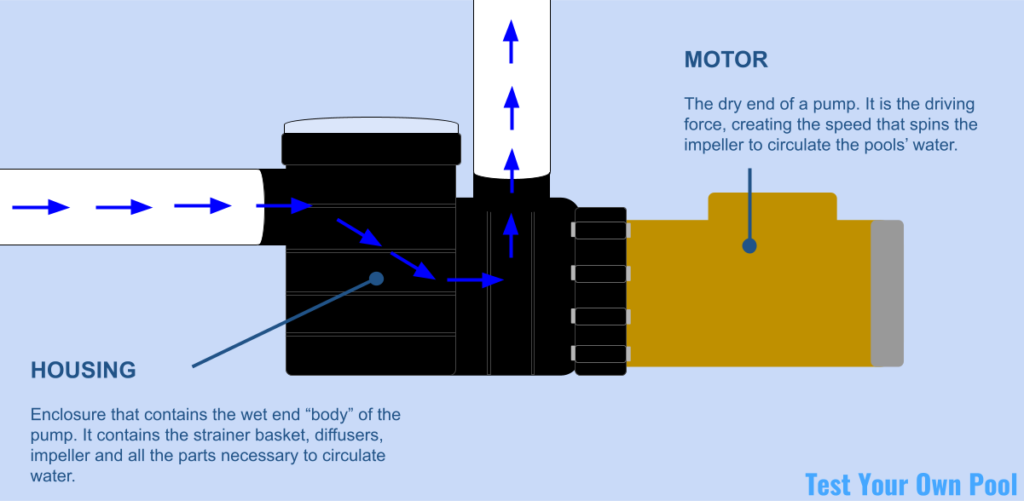
The wet end, appropriately named, is the part of the pump that the water flows through. It is in a water-tight enclosure called the housing. The housing contains a strainer basket to catch any large debris before it gets into the filter and other equipment. It also contains an impeller.
The Impeller is the pump’s pulling force. It sucks the water from the pool and pushes it back in. The impeller is what connects the wet end to the motor.
The Motor is the dry end of the pump, meaning no water enters it. It is the pump’s driving force, creating the speed that spins the impeller to circulate the water.
You may have heard “pump” and “motor” interchangeably when discussing pool pumps. However, there is a difference. The pump is the whole assembly consisting of the wet and dry ends, whereas the motor is just the dry end.
The pump is connected by PVC pipes, often called suction and return lines. These pipes are the veins that send water to where it needs to go to be filtered or heated.
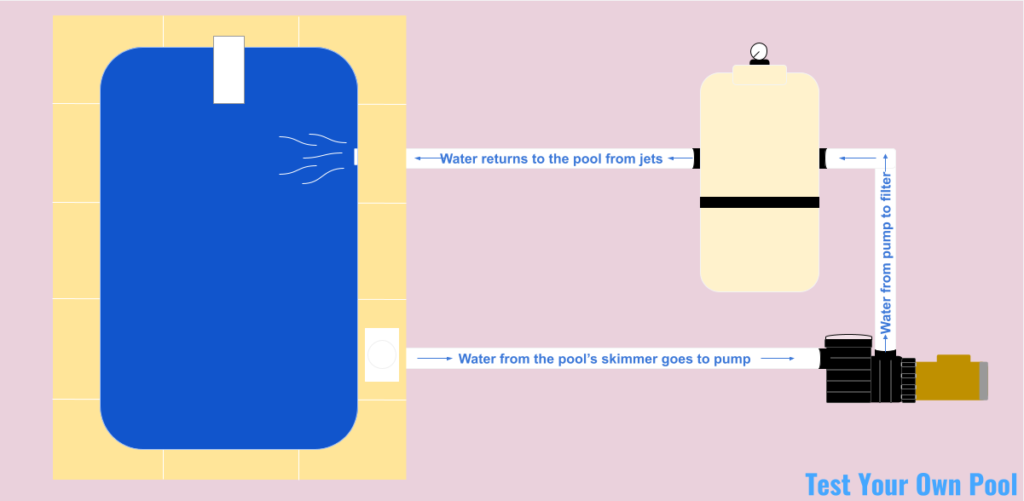
Choosing the Right Pump for My Pool
Plenty of options and features need to be considered for a pump, in addition to its RPMs. Choosing the wrong pump can hinder circulation and water filtration and damage other equipment.
The overall goal with a pump is maximizing efficiency. How can I maintain a water chemistry balance while saving money on electricity costs?
Determine the Correct Pump Size
Finding the right pump size for your pool typically refers to the pump’s horsepower (HP). The horsepower (HP) is how forceful and quick the pump can fully circulate the pool’s water. Residential pumps usually range from 0.75 HP to 3HP. Generally, it’s better to size up because you can always reduce the RPMs (if you have a variable-speed pump).
It is generally accepted that all pool water should flow through your filtration system at least once daily. This is known as the turnover rate.
To determine what size pump is needed, you need to do some math to find your pool’s flow rates, both a minimum and maximum flow rate. Essentially, how many gallons can the pump push over a period of time, and how much can the filtration system handle?
The most important information needed is knowing how much water is in your pool. If unsure, use a pool volume calculator to get a reasonable estimate.
Minimum Flow Rate
Divide the volume by your intended turnover rate time to find the minimum flow rate. For single-speed pumps, turnover is typically 6-8 hours. If you have a variable-speed pump, we can afford to move water a bit slower, about 8-12 hours. This will give you a Gallons per Hour (GPH) rate. Since most pumps calculate by minutes, we can divide the GPH by 60 to get Gallons per Minute (GPM). For example, a 25,000-gallon pool that we want to turn over in 8 hours would be:
25,000 ÷ 8 = 3,125 GPH ÷ 60 = 52.08 GPM
Your pump’s manual or specifications guide should have a section about its flow rates.
To make the GPM calculation easier, use our super-handy calculator to get a better idea!
Pool Turnover Rate Calculator
Maximum Flow Rate
The maximum flow rate is a little bit easier to find, as that is mostly determined by your filtration system: filters and plumbing (both pipe sizing and length). Your filter’s flow rate will be determined based on its size and surface area. The filter manual will have its maximum flow rate allowed.

Pipes are the other important factor when determining flow rates. You don’t want to put extra pressure on the pipes and put more water than they can handle. The pipes may have flow rates stamped on them, but if not, refer to these general numbers from Pool Parts to Go:
- 1.5″ pipes: 42 GPM
- 2.0″ pipes: 73 GPM
- 2.5″ pipes: 120 GPM
- 3.0″ pipes: 160 GPM
If your plumbing varies in size throughout its length, refer to the smallest pipe size‘s GPM.
Finally, refer to the smaller GPM flow rate between your filter and plumbing. For example, if your filter’s maximum flow rate is 96 GPM, but you have 2.0″ pipes throughout your system, use 73 GPM as your maximum flow rate.
Water Features
If your pool has a connected spa, waterfalls, spillovers, water slides, and other water features, it is highly recommended that you get a variable-speed pump.
The ability to control features with multiple flow rate requirements is very advantageous to overall circulation. You may even need multiple pumps within your system to ensure proper circulation throughout the pool.
The Different Types of Pool Pumps
While variable-speed pumps are recommended to future-proof your pool, other types are still available.
Besides a variable-speed, the two other popular types of pumps currently out on the market are:
- Single-speed pumps
- Dual-speed pumps
Single-Speed Pump
A single-speed pump will only operate at one speed according to the motor’s horsepower. Single-speed pumps have been the norm for pools for decades and are the choice for many residential owners.
The pricing of single-speed pumps compared to their multi-speed counterparts make them seem like an attractive option. However, due to rising energy costs and the fact that you can’t change the speed, single-speed pumps are the most expensive to operate!
Dual-Speed Pump
Dual-speed pumps give pool owners more flexibility in how fast the motor can run. The speeds are typically classified as low and high. High speeds are similar to a single-speed pump’s RPMs.
The low speed can sometimes cut RPMs in half, reducing energy usage and run-time costs—sometimes as high as 80%!
However, the low speed might not be fast enough to filter and circulate the water properly. Certain features, like spillovers or saltwater generators, might need a certain RPM level between the high and low settings, which may force you to operate at the higher level most of the time.
The Right Pool Pump Makes All the Difference
Your pool’s pump is the most important aspect of your pool. Water balance and proper testing can only be achieved if the water has proper circulation.
If and when you are ready to buy a new pump, take into consideration the long-term effects of the purchase, both from an energy efficiency and cost perspective. Variable-speed pumps are more of an upfront cost, but the electrical savings each will offset that cost in just a few swim seasons. Reach out to your energy provider to learn about any rebates that they offer and know you are doing your part to reduce electrical consumption!





